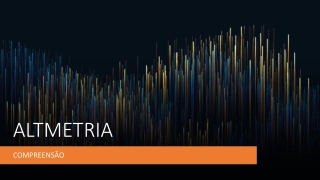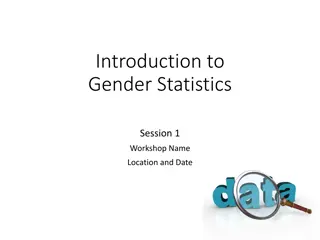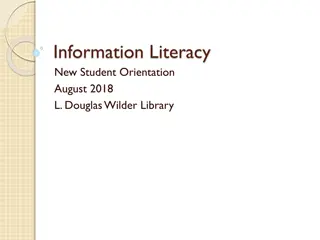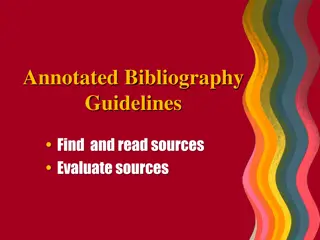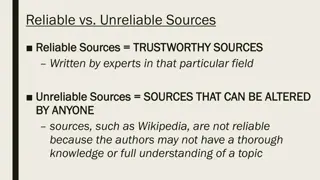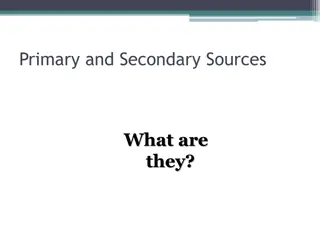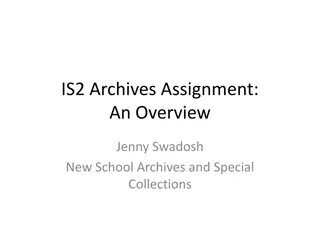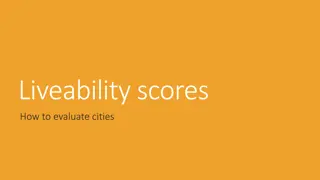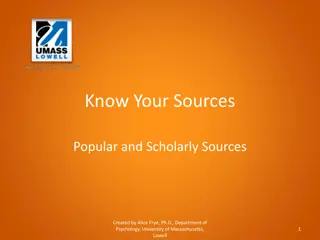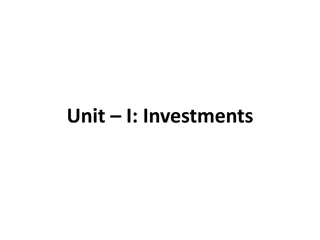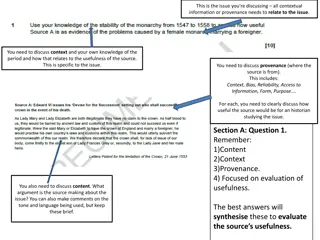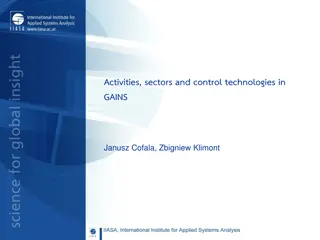Evaluating and Differentiating Sources for Research
Explore the methods to assess the quality and reliability of sources, differentiate between scholarly and non-scholarly sources, evaluate print, online, and multimedia resources, and conduct a CRAAP analysis for print resources. Learn how to navigate the responsibility of accessing information in the digital age effectively.
Uploaded on Oct 07, 2024 | 0 Views
Download Presentation

Please find below an Image/Link to download the presentation.
The content on the website is provided AS IS for your information and personal use only. It may not be sold, licensed, or shared on other websites without obtaining consent from the author. Download presentation by click this link. If you encounter any issues during the download, it is possible that the publisher has removed the file from their server.
E N D
Presentation Transcript
Writing Skills Lab Evaluating Sources
Learning Outcomes Evaluate the quality and reliability of sources Identify and differentiate different types of sources Evaluate methods to assess the quality of print sources Evaluate methods to assess the quality of online sources Evaluate methods to assess the quality of multimedia sources
Research Where do you go to find research materials? Well, that s more complicated for you than it was for students fifty years ago. Before the Internet, as an undergraduate researcher, you were responsible for the sources available in your college or university s library. Under certain circumstances, materials could be obtained from other libraries through interlibrary loan services. Things have changed. As the saying goes, with great power comes great responsibility: the Internet, and all the information associated with it, is now available to you as a researcher. You are responsible for a lot more than is contained within the walls of the library.
Scholarly vs. Non-Scholarly Sources Sources can be broken down into three categories: print, online, and multimedia. Scholarly or academic publications are those where academics publish their research about topics of concern in their discipline. Non-scholarly or popular sources tend to be written by journalists and writers who are not necessarily experts about the subject they are writing about.
Activity What are some examples of scholarly and non-scholarly sources? How are they similar? How are they different?
Print Resources Simply put, print sources are sources that have been published in printed format, such as many daily newspapers, magazines, academic or trade journals, books, government reports, etc. Many print sources can be accessed online. The distinguishing feature of print sources is that they may be accessed in printed form, not that you have accessed them in printed form. Regardless of how you access a print source, it is important to pay close attention to their credibility and reliability.
CRAAP Analysis of Print Resources Currency: the timeliness of the information Relevance: the importance of the information for your needs Authority: the source of the information Accuracy: the reliability, truthfulness, and correctness of the information Purpose: The reason the source exists
Online Sources Online source material is extremely popular and its use in academic work has grown exponentially over the past several years. We define online sources as websites and publications available only online, as you will evaluate other multimedia sources in the next section. There are two types of online sources that you may use in your work: sources that are solely online and sources that are online but are exact versions of what is available in print form. We will look exclusively at sources that are only available online, as you evaluated print sources in the previous section.
CRAAP Analysis Online Resources Currency: the timeliness of the information Relevance: the importance of the information for your needs Authority: the source of the information Accuracy: the reliability, truthfulness, and correctness of the information Purpose: The reason the source exists
Multimedia Sources There are many sources that you may encounter in your research that may not neatly fall into the categories of print or online. Multimedia sources, or those that use forms of media other than text, can provide valuable content for your writing.
Practice Question What are some examples of multi-media sources? List as many as you can think of without stopping.
CRAAP Analysis of Multimedia Resources Currency: the timeliness of the information Relevance: the importance of the information for your needs Authority: the source of the information Accuracy: the reliability, truthfulness, and correctness of the information Purpose: The reason the source exists
Quick Review Now that you have learned the CRAAP method, make source evaluation an integral part of your research and writing process. When assessing a potential source, ask the key questions below: When was the source published or produced? How does the source contribute to my paper? Is the person, organization, or institution responsible for the content of the print source knowledgeable in that subject? How free from error is the source? Who is this information written for, or who is this source developed for? The ability to evaluate sources for reliability and credibility will serve you well not only in your academic career, but in your professional, civic, and personal lives, as well.


